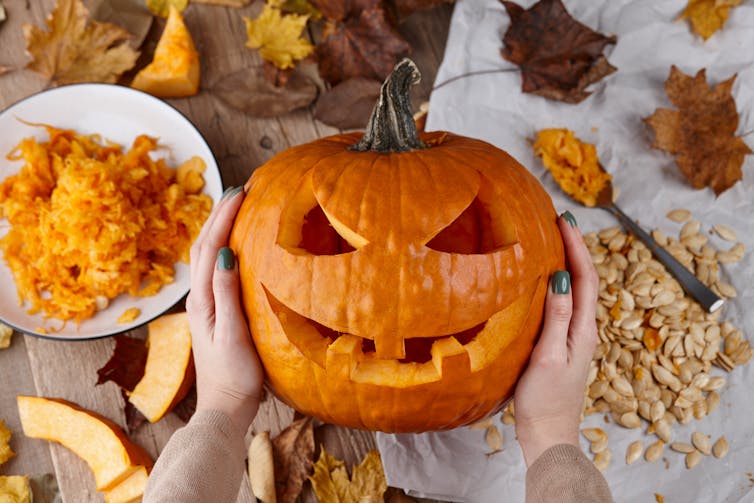Pumpkins are synonymous with autumn. But while most of us associate them with Halloween, pie and pumpkin spice lattes, these fruits are in fact extremely versatile. And depending on how they’re prepared, they can be good for your health.
Though pumpkins are grown all year round, most of us only buy them in October for carving into jack-o’-lantern. This means many are missing out on a surprisingly nutritious food from their diet. Pumpkins are nutrient-dense while being low in calories. They contain a variety of vitamins, minerals and antioxidants that each have different benefits for our health.
Here are just a few of the reasons you should consider including pumpkins in your diet.
1. They’re a source of antioxidants
Pumpkins contain high levels of antioxidants. These are molecules that fight harmful free radicals (a type of unstable molecule that can sometimes cause damage to our cells, which may cause ageing and contribute to various diseases over time). While some antioxidants occur naturally in our bodies, others we get from fruits and vegetables.
The high antioxidant content in pumpkins could therefore be associated with a lower risk of developing certain diseases, such as heart disease and cancer.
Pumpkins are also one of the best sources of the antioxidant beta-carotene. Not only does this give pumpkins their vivid orange colour, but it’s also converted into vitamin A which is essential for good vision, our immune system and even heart and lung function.
Pumpkins also contain vitamins C and E, antioxidants that are known to strengthen our immune systems. In addition, vitamin C is important for wound healing and helping the body build collagen – a fibrous protein used in our connective tissues – including our bones, muscles and even blood. Vitamin E on the other hand is good for preventing clots from forming and may also be good for our skin, hair and nails.
2. They’re full of important minerals
Pumpkins contain both iron and folate.
Iron of course is important in helping our red blood cells carry oxygen from the lungs to tissues around the body. It also helps to keep our muscles and connective tissues healthy. Iron helps to preserve many vital functions in the body including energy and focus, gastrointestinal processes, the immune system, regulation of temperature and growth and neurological development.
Folate, also known as vitamin B9, is an essential nutrient that supports the formation of DNA and RNA. This is why it’s particularly important during pregnancy, infancy and adolescence. Low levels of folate are associated with an increased risk of several health conditions, including birth defects and cardiovascular disease. Research also shows that folate is linked to a reduce risk of pancreatic, oesophagal and colorectal cancer.
It should be noted that pumpkins are high in potassium, too, so patients on dialysis will need to limit their intake.
3. Even pumpkin seeds pack a punch
Although they’re small, pumpkin seeds are also packed full of valuable nutrients.

kobeza/ Shutterstock
For example, pumpkin seeds contain magnesium, a mineral that supports muscle and nerve function, regulates blood pressure and supports the immune system. They also contain zinc, which alongside supporting our immune system also plays an important role in cell growth, building DNA and protein and healing damaged tissue.
Another perk of pumpkin seeds is that they contain unsaturated fatty acids, which help lower levels of LDL cholesterol (often known as “bad” cholesterol as it contributes to fatty build-up in arteries and can raise the risk of heart attacks or stroke, reduce inflammation and strengthen our cells).
They also contain many of the same antioxidants pumpkins do.
How to prepare your pumpkin
Pumpkins are a versatile fruit that is regularly consumed in many different parts of the world. It can be prepared in a variety of different ways.
For example, when carving a jack-o’-lantern this year, instead of throwing your seeds away, separate them from the flesh, rinse them off, and set them to the side. Once they’re dry, roast them – either plain or perhaps consider topping them with honey. This is a popular dessert in Mexico known as palanquetas. You can also use the flesh (or pulp) in several dishes, including in soup or a puree, or even in desserts, such as muffins, pudding or flan.
The fruit itself can be peeled and prepared or eaten as you would any other vegetable. As with other winter vegetables – such as squash – it goes particularly well with chilli, nutmeg and sage. Or perhaps you’d like to try preparing your pumpkin as they do in other parts of the world. In Armenia, pumpkin is used in the dish ghampama, in which the inside of a pumpkin is stuffed with boiled rice, dried fruits, nuts and honey before it’s cooked. Or maybe you’d prefer to try South African pampoenkoekies, which are tiny pumpkin fritters made with cinnamon and nutmeg.
Each year thousands of acres of farmland are used to grow pumpkins which are merely carved and then thrown away. This could be considered a waste of valuable, nutritious and delicious food. So this year, you might want to consider turning your jack-o’-lantern into a delicious, homemade meal instead.
![]()
Hazel Flight does not work for, consult, own shares in or receive funding from any company or organisation that would benefit from this article, and has disclosed no relevant affiliations beyond their academic appointment.











